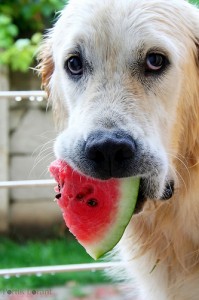Some Crassers have been concerned lately about what’s bad for their pets to eat, and just how much is really horrible. The bad news: there are a lot of things that will poison your cat or dog. The good news: it usually takes a lot to do harm. So here’s a helpful guide to what’s going to cause you to clean up gallons of vomit and what you can do in an emergency.
You can find a comprehensive list here, but we’ll focus on the most common things, and some of the less common things that can cause big problems.
See, that list above basically includes everything you have in your house for your consumption. Here’s the bottom line, and I say this as a pet owner and not a medical professional: You don’t need to worry as much as you do. Few things short of drinking bleach straight from a water bowl will be fatal. And while your dog or cat should only be eating food and treats specifically formulated for their species and their specific needs, some pets are opportunists. They’ll grab anything that isn’t nailed down off the counter, including but not limited to knives, raw chicken and whole onions. They’ll beg for a grape or a carrot.
So, if you are an enabler and can’t resist little Snappy’s begging, or just turned your back for a second while your dog ate everything off your cutting board, it’s not a total crisis. So breathe. Read this. Print a copy and keep it near your heart. This article wards off vampires and mosquitoes as well.
First up: chocolate. Yes, chocolate is bad for dogs and cats. It really can kill them. But here’s the thing: it’s the cocoa in chocolate that’s poisonous, specifically a chemical called theobromine. Consequently, the higher the amount of cocoa in the chocolate, the more dangerous it is. So getting ahold of a couple Hershey’s miniatures isn’t going to cause your dog or cat to drop dead. But unsweetened baker’s chocolate might, especially if you have a smaller animal. Chocolate poisoning, even a mild toxic reaction, will often result in vomiting and diarrhea.
For a 22 lb. dog, this translates into about 20 oz of milk chocolate, 10 oz of semisweet dark chocolate, or 2.25 oz of baking chocolate on the low end of the fatal range. To put that in perspective, a dog would have to eat 13 standard-size Hershey bars to get the lowest possible amount of theobromine to cause a fatal reaction. A 70 lb Labrador would have to eat at least 36 bars. So while you never want to feed your dog chocolate, and smaller breeds especially need to be kept away from your stash, a tiny bit of chocolate isn’t going to require a vet visit in most cases.
For both cats and dogs, garlic, onions, and grapes can be very toxic. Grapes can be bad for dogs; there’s some evidence that a substance found in them can cause renal failure. However, it’s still not clear what chemical causes the reaction, and in what quantities, or even if all dogs are affected. Ingesting garlic or onions causes a reaction in both cats and dogs that destroys red blood cells, and eating a large amount once or even eating small amounts regularly over time can lead to anemia. Symptoms of anemia include vomiting and severe lethargy.
And let’s dispel a myth once and for all today: milk is bad for cats. It’s not poisonous, and cats may enjoy it, but they’re unable to digest it properly. Cats are actually lactose intolerant. It does cause gastric upset as it does in lactose-intolerant humans, including very smelly stool. The higher the fat content in dairy, the less lactose, so if you really don’t mind the smell, whole milk or cream as a treat is fine, but don’t overdo it. And if you are feeding stray cats or kittens, milk is never a substitute for nutritionally balanced dry or wet food.
A quick note about medications: while you will always want to check with your vet if your pet gets into any kind of medications, many “human” medications, including NSAIDs, SSRIs and Benadryl, are also used in animals. So a small dose will likely pose no problem at all.
What do you do if the worst happens and your dog or cat has ingested a lot of a toxic food or substance? Again: stay calm. If you’re balled up in the corner sobbing and moaning “he’s gonna DIEEE” over and over, you’re not helping anyone. You’re going to want to determine, if possible, exactly what they ate and how much of it. Jot that down really quick. If you have a wrapper or bottle, keep that too.
The next thing you need to do is call either your vet, your emergency vet, or animal poison control. I highly recommend having all these numbers in a pet first aid kit at the ready. If you haven’t yet, get the number of the nearest 24-hour emergency vet. This is absolutely a must, because if your dog gets hit by a car at 2AM, you are not going to want to mess around on Google while he’s bleeding.
Keep the number to the National Animal Poison Control center handy: (888) 426-4435. It’s run by the ASPCA and you will be able to talk to a live person with training 24/7. Keep in mind there is a $50 fee in some cases. There is no better resource though, and fifty bucks is a small price to pay for assistance and peace of mind.
During the day, if you have an emergency, your vet will be able to tell you right away whether you need to come in. After hours, in a poison situation where your pet is not immediately and seriously ill, calling the hotline is your best bet. However, if your dog or cat is vomiting or excreting blood, if their breathing is shallow, if they are unable to move, don’t bother. Get them in the car and call the emergency vet on the way. If they’ve ingested large amounts of something like baker’s chocolate or drain cleaner, don’t wait a second.
If your pet is very young or old, or suffers from other serious medical problems like heart trouble or kidney disease, you’ll also want to be extra vigilant. An animal who’s already cardiac compromised or otherwise less able to process toxins in the body will have a more serious reaction to toxins.
If it’s less immediately serious, though, staying at home and doing some simple things can prevent a big vet bill and a lot of worry. You should have either hydrogen peroxide or syrup of ipecac in your first aid kit. Ipecac is preferable because using peroxide as an emetic can sometimes cause ulcers. If they just wolfed down something and you can get them to vomit it back up right away, you’re golden. You’re also cleaning up puke for the next hour, but whatever.
You’ll also want to monitor your dog’s behavior. They may be a little lethargic but do make sure they’re eating or drinking, even if it’s less than usual. The biggest concern with poisoning is the dehydration caused by vomiting and diarrhea; in most cases of poisoning, the care is supplemental, monitoring bodily functions and making sure hydration levels remain stable. If they haven’t eaten or drank anything in 24 hours, they may need intravenous fluids.
Ultimately, if your pet eats something they shouldn’t, they’ll very likely be just fine. Millions of animals eat a box of raisins or a few pieces of chocolate every year, and only a very small percentage suffer any serious adverse effects. My suggestion? Keep some Valium and a small bottle of vodka in that first aid kit– for you, of course.
More helpful links and numbers:
- National Animal Poison Control Center
- HSUS List of Dangerous Foods
- Find an emergency vet in your area
Have more questions? Ask in the comments, find me on Twitter, or email TrainingCornerNerds -at- gmail.
Top image Flickr.


